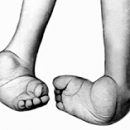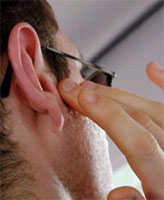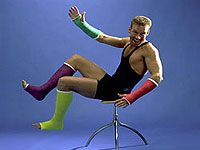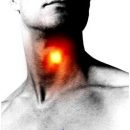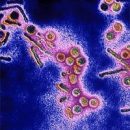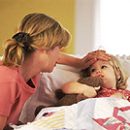Which doctor makes a diagnosis? What to do if parents suspected a child's signs of closures? Answers to these questions you will find in the article.
Content
A rare parent does not touch the kid's bitch. Even adult collencers diligently put inside the socks of their 43rd boots, if they want to show a small child.
Many parents do not even guess that in the mouth of the word doctors «Congenital closure» - This is a serious diagnosis. On this problem, we are advised by the orthopedic department of the recovery treatment of DGB No. 5 Oleg Viktorovich Zaitsev.
Convolution - these are several elements of the deformation of the foot. Violations are laid in intrauterine development. Therefore, this pathology is called congenital. The reasons for its occurrence, as far as I know, no one can explain. Different sources are given different theories, but they all reduce the fact that disorders appear at the stage of formation of soft tissues of the lower leg and foot. And with which it is connected, no one can explain. After all, the basics of the musculoskeletal system are laid in the second week of pregnancy, when a woman still does not know about her.
I believe that the development of closures is influenced by the intrauterine position of the fetus: if he lay in a curved form due to a foot adjacent or a fruit, maybe he felt squeezed with muscles of the uterus, or the leg was pulled by umbilical. To gradually straighten the foot, you need to make force. The acquired closet may arise as a result of complex injury.
Question number 1. Which doctor makes a diagnosis?
Diagnostic closure must be a doctor in the hospital, and the first recommendations give a surgeon or orthopedist. For this, parents must come to consult in the first days after discharge from the hospital. It is very important to notice pathology as early as possible and begin treatment. After 6-monthly age, conservative treatment no longer has effect, and launched cases lead to operation.
Question # 2. And parents can see themselves that the child has something wrong with the legs?
If the baby's baby is unnaturally bent or curved and turned to the middle line of the body, and attempts to output the foot in a normal position do not bring results, you should urgently consult with your doctor.
Question number 3. And when you need to contact a specialist?
The most golden time for the treatment of closures is age from the moment of healing the cords up to eight months, before the child starts walking. Otherwise, his pathological motor stereotype is formed, and the gait will be defective. While the child is small, his skeleton like plasticine. From plasticine cut out a new form is much easier than to sharpen a stone. At an older age, the defects that could be eliminated without the surgery of the surgeon have to operate.
Several types of closures are distinguished:
- bone;
- soft or muscular;
- Neurogenic, when peripheral neuralgic disorders cause foot bare;
- amniotic halves;
- arthrogriposis.
Muscular and neurogenic closures are well amenable to conservative treatment, that is, without surgery. As a rule, the stop takes a normal position, and the closure is displayed in the flatfoot. After all, flatfoot and closure are two opposites. Kids are the first to be the norm, and the second - pathology. Bone closure is displayed in the desired position using the operation. But the main task of the surgeon is not to bring the case to surgery.
Question number 4. What treatment can prescribe a doctor?
Special Gymnastics, Massage, Warm Baths, Stimulating Physiosters for Lumbar-Nervous Plexus. Euphilline electrophoresis or paraffin warming improves blood circulation, which, with such deformations, suffers especially. Stop fixation is also prescribed «SAPOOK». Previously, for these purposes, tight binting and plaster imposition. It was very uncomfortable, took a lot of time, and the gypsum was needed to change every week. Under the plaster, the bones of the legs were incorrectly formed, and the knee, and the hip joints were also.
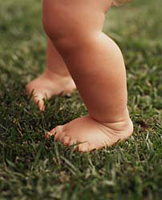
Today for «Sapozhka» Using modern polymer materials, such as, «Polyvik». Such boots can be called and «Longheta», and «tutor». Sleeping from the polyvik is not done on the leg of the patient, but on the mannequin. That is, in accordance with the ideal, to which you need to strive. The leg remains partially open and at the same time firmly fixed. (In appearance it is a little resembles the winged sandals of Hermes from the famous cartoon. - author).
Very well engaged in such correction in the center «Special child» on a visa. It is more difficult for the operational treatment of closures. From your experience I know that the operated patients still can not be considered perfect healthy. For example, the operated foot can stay for several sizes less. Muscle atrophy develops, which is why one leg looks thin. We account for all life to wear special orthopedic shoes, the gait suffers, the curvature of the spine and neurological disorders may develop. By the way, after conservative treatment, there may also be a breakdown of gait, and other deviations from the norm. The person becomes a disabled, because there is a closure - this is a urtising factor, the functions of the patient and the legs are broken. Therefore, it is very important to diagnose in time.
It is harder to reveal the closer when signs are expressed nonresko. If you do not notice this little thing in a newborn and miss the time, then these neurological disorders will remain with a person for life. And the bouncing gait, and the gait with swallowing socks inside is the signs of peripheral neurology, pyramidal insufficiency syndrome. Difficulties in the treatment of closures are that often parents turn to doctors in a non-time. Regardless of whether the conservative or surgical treatment was carried out by the patient, there is a threat of recurrence, if the patient neglects a regular visit to the doctor who observes the patient until the end of the growth period. All these violations need to be treated in childhood so that adults were healthy.
Specialist recommendations:
- As early as possible to learn about pregnancy. Express tests can be used.
- Be sure to pass an ultra-sound study during pregnancy.
- Consulted as an orthopedic doctor as soon as possible, if you recommend this doctor in the hospital or district pediatrician.
- Time to treat the baby, fulfilling all the recommendations of the doctor.
- After treatment, it is necessary to regularly observe the doctor until the end of the patient's growth: girls - up to 16 years old, boys - up to 19 years old to avoid recurrent closures.


